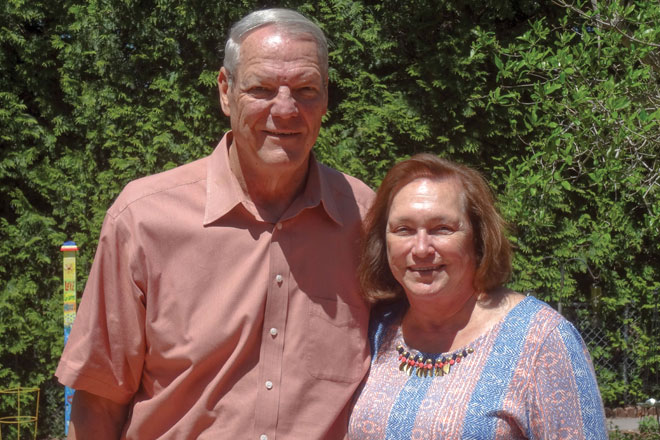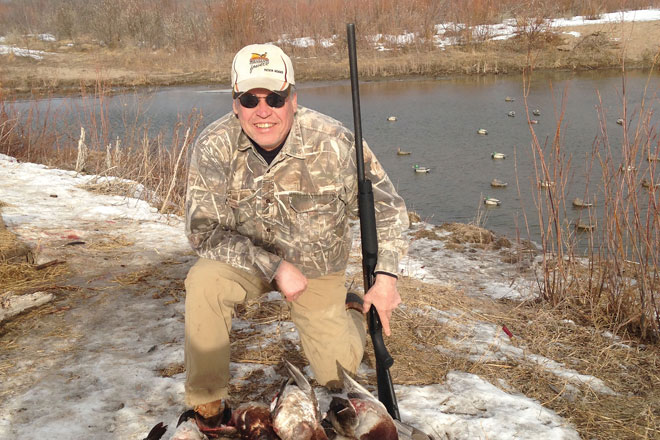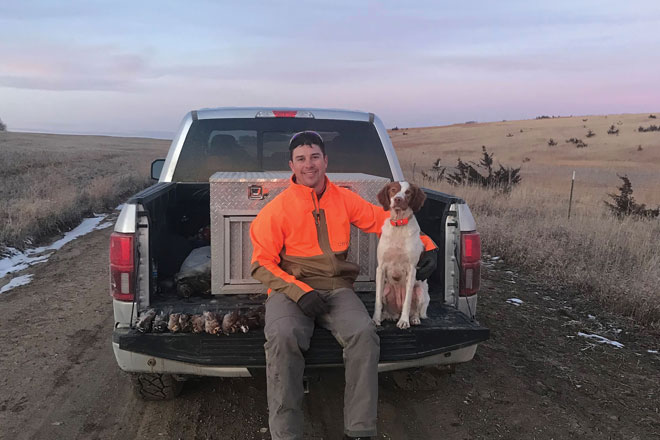By Andrew Johnson
Along with the call to experience the uplands comes the call to care for them. Here are three stories of extraordinary supporters who have helped lay the financial foundation of Quail Forever’s first-ever national fundraising campaign,
Call of the Uplands®.
Bob and Sue Greving
Bob and Sue Greving met over five decades ago at Briar Cliff University in Sioux City, Iowa. Sue grew up on a farm in southeastern Minnesota, while Bob was a city boy from Quincy, Illinois.
From humble beginnings, the couple says a love for the outdoors has only strengthened the bond between them and played a large part in their lives as they raised their two children and then helped raise four grandchildren. Today, the Grevings are enjoying retired life from their home overlooking a lake in south-central Tennessee.
 Member photo
Member photo
"Bob was an actuary, and at his last couple jobs he was CFO and chief actuary,” Sue explains. “He worked hard, and I was the one that kept everything else going.”
Bob admits he’s been an outdoorsman all his life, saying his passion for hunting started when he was a boy hunting small game in Illinois. Because she grew up on a farm, Sue says she has been around hunting her entire life and has harvested a number of big-game animals. However, she says bird hunting is still rather new.
“This fall was the first time I went out to shoot birds,” she admits. “We went dove hunting, and I hit three.”
Fur or feathers doesn’t matter too much to the Grevings when it comes to conservation, though, as they have always supported a number local and national conservation groups, including Quail Forever.
More recently, however, Bob and Sue stepped up their donation to Quail Forever and designated $33,000 toward Quail Forever’s habitat efforts in Tennessee as part of the Call of the Uplands campaign. More specifically, the Grevings’ financial gift will be leveraged with matching funds to support ongoing habitat projects and quail restoration efforts at the Bridgestone/Firestone Centennial WMA, a 10,000-acre property that sits smack dab in the middle of the Volunteer State.
“I’ve seen the restoration of the white-tailed deer. I’ve seen the restoration of the bald eagle and the wild turkey. And now I’d love to see the restoration of the bobwhite quail,” Bob says. “It’s been devastated everywhere I’ve been in the Southeast and on up and through parts of the Midwest. We’ve also seen first-hand how much of the pinewood savanna was lost here in Tennessee, and we decided we wanted to make a difference here close to home.”
To that end, the ability to help guide how their donation would be used played a large part in the Grevings’ decision to answer the call of the uplands.
“One reason we agreed to donate is we could designate where we wanted the money to go,” Bob says, “and we wanted this money to support this particular project.”
Sue echoes those thoughts and says the proof is in the pudding.
“We only live a short distance from the Bridgestone/Firestone property, so at one point we asked for a tour,” she explains. “It was an awesome tour, and it was really good to see how our money was being put to work instead of it going somewhere where we would never really be able to tell how or what it’s helping.”
Even better, during the tour the Grevings and about three dozen other people were provided a special treat.
“There are now several wild coveys of quail on the property, and while we were there we could hear wild quail calling to each other,” Bob says. “It was really neat and really satisfying to hear that. I don’t think it’s something either of us will soon forget.”
The Grevings became life members of Quail Forever as an extension of their Call of the Uplands contribution, but they never sought status or recognition as a result of their generosity. Rather, they simply felt blessed, Bob says, so they wanted to turn that around and find ways to bless others. More importantly, they hope sharing their story will inspire others to give back in some way, shape or form.
“We’ve received so much from nature and being in the outdoors in our lifetime that we feel it’s our duty to preserve as much as we can,” Bob says. “If people step outside their homes into nature, there’s so much to appreciate and enjoy, and preserving that has value not just for the individual, but for everybody.”
Gerry Horak
Gerry Horak grew up in urban parts of Maryland before moving to Colorado when he was 27 years old. However, it took another eight years before he really started on his path through the uplands.
“In Colorado I worked with a lot of folks who were with the U.S. Fish and Wildlife Service, so I got to know them and got to be friends,” he recalls. “When I was 35, I went on my first hunt, which was a sage grouse hunt. I had a side-by-side at the time, and when the first sage grouse got up I just had to look at them because I couldn’t get the safety off.”
 Member photo
Member photo
Horak has now called Fort Collins home for decades, and now says his ideal day is hunting ducks along the Platte River in the morning before moving to the uplands in the afternoon for pheasants. In addition to his home state of Colorado, he also enjoys hunting in other states, and this past fall he spent time chasing birds in Montana, Kansas and both Dakotas.
Whether it’s at home or through his travels, Horak says it doesn’t take a rocket scientist to see how long-term drought coupled with sustained habitat loss is negatively affecting wildlife, including upland birds.
“If you travel around, one of the things that comes up right away is how much less CRP there is, and being in these states and looking at things, the drought has just done so much damage,” says Horak, who answered the call by becoming a Gold Patron Member of Quail Forever this past year. “I’m not a rich guy. At the same time, I don’t owe any money, so I can choose to invest where I want. And I choose to invest in the work Pheasants Forever and Quail Forever are doing, because I want to improve the structure of the habitat.”
A primary reason he increased his support is he believes in PF & QF’s unique fundraising model.
“I first got interested in Pheasants Forever and Quail Forever because the nature of the organization is that, beyond basic membership dues and things like that, all the money raised at the local level goes to local efforts, whether it’s education, paying for farm bill biologists, lobbying, land acquisitions — you name it,” he says. “It’s an individual choice made at the local level, where it’s not mandated that money goes straight to the national organization. I think it’s a wonderful way to really get local involvement.”
Like most passionate hunters, Horak admits his contributions toward conservation are a bit self-satisfying, because more than anything he says hears the call of the uplands the loudest through the flurry of excitement created by a close-flushing bird. To Horak, chasing that feeling is at the core of why he hunts, and he says preserving and creating wild places for wild things ensures that he and others can maintain the chase well into the future.
“To this day nothing is more exhilarating to me than the sound of a flushing upland bird. I’ve never tired of that,” he explains. “But what I truly love about hunting, whether it’s for waterfowl or upland birds, is just being out there. I just like going out, seeing what you’re hunting, having a chase, hopefully being successful, processing it and then eating it. I enjoy the whole experience, but I enjoy it if I am only able to do the first part. That’s just what hunting is like. You don’t know the ending. It’s always something different, which always makes it interesting.”
John Almeida – QF Patron Member
Although John Almeida grew up in a military family, he admits firearms were a bit of a mystery until later in life. In fact, in 2007 right after he married his wife, Becki, he helped sell off her step-dad’s gun collection, not thinking twice about it at the time.
“He had a whole closet of guns and a big gun safe, and my mother-in-law showed it to me and said I was welcome to all of it,” Almeida remembers. “I told her that I didn’t shoot guns, suggested she sell them and then helped her do just that. I didn’t have anything against guns. I just didn’t grow up with them.”
 Member photo
Member photo
About a year later, he said his co-worker, Jeff Werthmann, suggested sporting clays as a way to get out and be more social.
“I hesitated at first, because I didn’t know what I was doing and didn’t feel comfortable, but he eventually got me out to shoot,” Almeida concedes. “I actually really enjoyed it, so I started to do it more and more. Then, he even somehow convinced me to show up for hunter’s ed.”
Taking things a step further, Werthmann also persuaded Almeida to try hunting right after parts of Kansas got a couple inches of snow.
“He had talked me into getting my hunter’s education, but I told him there was no way I was going hunting, especially if it was going to be cold and snowing,” Almeida says. “But the next day there I was, marching through this snowy field. The wind was howling, it was freezing cold and I was questioning why anybody in their right mind would do this.”
At the end of the first field a covey of quail buzzed Almeida’s tower, but that was only a primer for the real magic that was to happen moments later when a rooster pheasant would flush from right under his feet.
“I shot three times at that bird and didn’t draw a feather,” he laughs. “It was a total adrenaline rush, and one of the coolest things I’ve ever experienced. I probably shot at 30 birds that day, didn’t hit any and had the time of my life.”
Almeida says the hunting bug bit him hard that day — so hard, in fact, that a year later he had a bird dog of his own.
“Then, the year after that I have a second bird dog, and the year after that I have a bird-dog trailer and am traveling around the country. Today, I’ve got three dogs and hunt anywhere from eight to 10 states a year,” says the 43-year-old Almeida, who isn’t shy at all about becoming an adult-onset hunter. “Since that first hunt, I’ve gotten four or five of my other buddies started or interested in shooting and hunting enough to the point they hunt every year and love it, too.”
In addition to passing on the outdoor traditions of hunting and shooting to other adults, Almeida has also become a staunch advocate for conservation. A healthcare real estate developer by trade, Almeida notes that he’s seen first-hand how the landscape has changed along with its direct impact on wildlife.
“From when I started hunting a dozen or so years ago, I can tell you there’s been a pretty drastic decline in habitat, and as we all know, quail and pheasants, along with huns, sharptails, prairie chickens and all other upland birds, are all highly tied to habitat,” states Almeida, who recently became a patron member of Quail Forever as part of the ongoing Call of the Uplands campaign. “The world is made to be sustainable and renew, and we have to find a balance between those that want to do right by the world, those that have a right to earn a living and own the land, and those that want to use the land for hunting and other recreational purposes. We have to find that sweet spot where all those circles cross, and that’s where we’ll find a win.”
Today, Almeida and his wife live on an acreage outside of Gardner, Kansas, just southwest of Kansas City, where they’re busy raising two young daughters, ages nine and five.
“My oldest just shot her first clays this fall,” he says. “It was a pretty proud dad moment, and she’s looking forward to doing it again. So, I guess you could say I’m now passing it on to one more person.”
Andrew Johnson reports and writes regularly for Quail Forever and Pheasants Forever. He lives in Tea, South Dakota.
The Call of the Uplands is Quail Forever and Pheasants Forever’s first-ever comprehensive national campaign. This represents a $500 million effort designed to enhance over 9 million acres of upland habitat, permanently protect 75,000 acres through fee-title acquisition and conservation easements, and to cultivate the next generation of conservationists by providing over 1.5 million Americans with outdoor experiences from the West’s expansive landscapes and the vast Great Plains, to the quiet southern pine woods. This campaign is our best chance to bring together dedicated citizens, hunter-conservationists, farmers, ranchers, and other partners with a common cause: A promise to conserve our uplands before it's too late.
This story originally appeared in the 2022 Winter Issue of the Quail Forever Journal. If you enjoyed it and would like to be the first to read more great upland content like this, become a Quail Forever member today!